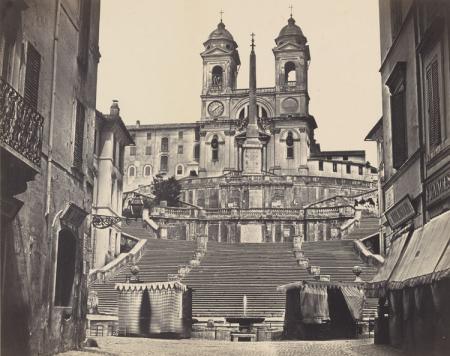
1856

1975
Directly above the Piazza di Spagna, and opposite to the Via de’Condotti, rise the double towers of the Trinità dei Monti. The ascent to them is over one hundred and thirty-five steps, planned with considerable skill, so as to mask the steepness of the Pincian, and forming the chief feature of the Piazza. Various landings and dividing walls break up their monotony; and a red granite obelisk, found in the Gardens of Sallust, crowns the upper terrace in front of the church. All day long, these steps are flooded with sunshine in which, stretched at length, or gathered in picturesque groups, models of every age and both sexes bask away the hours when they are free from employment in the studios. ... Sometimes a group of artists, passing by, will pause and steadily examine one of these models, turn him about, pose him, point out his defects and excellences, give him a baiocco, and pass on. It is, in fact, a models’ exchange.
—William Wetmore Story, Roba di Roma, II, 495–496
Over the course of the eighteenth century, the Piazza di Spagna became the hub around which hotels, lodging houses, and shops catering to tourists and foreign residents were situated. In 1820 John Keats spent the last three months of his life in a house overlooking the Spanish Steps—partially visible on the right. The piazza was also the center of the artists’ quarter. The Caffè Greco, where Macpherson regularly met with other photographers and artists, is nearby. The concentration of foreigners and artists around the Spanish Steps also attracted a picturesque population of models.
Robert Macpherson, The Spanish Steps, ca. 1856. Collection W. Bruce and Delaney H. Lundberg. Photography by Graham S. Haber
Location photography by John Pinto
